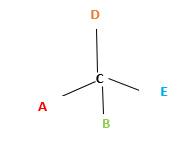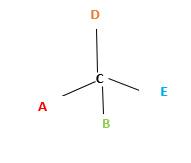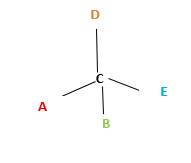
Concept explainers
(a)
Interpretation:
Chirality center of the
Concept Introduction:
Chirality is the presence of an asymmetric carbon center in a molecule and a molecule which contains a chiral center cannot superimpose on its mirror image.

In the above diagram, where C is the chiral center/ asymmetric carbon center.
A, B, D, E are four different
Answer to Problem 30P
In
Explanation of Solution
The
(b)
Interpretation:
Chirality center of the
Concept Introduction:
Chirality is the presence of an asymmetric carbon center in a molecule and a molecule which contains a chiral center cannot superimpose on its mirror image.

In the above diagram, where C is the chiral center/ asymmetric carbon center.
A, B, D, E are four different functional groups.
Answer to Problem 30P
The compound

Explanation of Solution
The
The chiral center is represented as follows:

(c)
Interpretation:
Chirality center of the given molecule, should be labeled and identified.

Concept Introduction:
Chirality is the presence of an asymmetric carbon center in a molecule and a molecule which contains a chiral center cannot superimpose on its mirror image.

In the above diagram, where C is the chiral center/ asymmetric carbon center.
A, B, D, E are four different functional groups.
Answer to Problem 30P
Inmolecule there are no chiral centers present.
Explanation of Solution
The

Therefore, molecule does not contain any chiral centers.
(d)
Interpretation:
Chirality center of the given molecule, should be labeled and identified.

Concept Introduction:
Chirality is the presence of an asymmetric carbon center in a molecule and a molecule which contains a chiral center cannot superimpose on its mirror image.

In the above diagram, where C is the chiral center/ asymmetric carbon center.
A, B, D, E are four different functional groups.
Answer to Problem 30P
Inmolecule there is only one chiral center is present. Refer the below mentioned diagram.

Explanation of Solution
The
C atom which bonded toone

Want to see more full solutions like this?
Chapter 15 Solutions
General, Organic, and Biological Chemistry - 4th edition
- What is the chiral center in each compound. R or Sarrow_forward8. Assign each chiral carbon as R or S in compound-A. Draw the mirror image of compound-A and assign configuration to each chiral carbon. (note that the dotted line represents the mirror). H₂N S OH Compound A CH3 CH3 mirror CH3 CH 3 Mmok NHZarrow_forwardLabel the chirality center (if one exists) in each compound. A compound may contain zero or one chirality center.arrow_forward
- Locating Stereogenic Centers Locate the stereogenic centers in each drug. Albuterol is a bronchodilator— that is, it widens airways—so it is used to treat asthma. Chloramphenicol is an antibiotic used extensively in developing countries because of its low cost.arrow_forwardOne of the analgesics has a chiral center. Which compound is it? One of the two enantiomers is far more effective at reducing pain than the other.arrow_forwardA) ОН B) HO. Molecule A is achiral and molecule B is chiral Molecule A is chiral and molecule B is achiral Both molecules are achiral. Both molecules are chiral.arrow_forward
- How many chiral center(s) are present in each molecule and how many stereoisomers are possible in each case? a) 2- Chloropentane b) 3- chloropentane c) 3- Chloro- 1- pentene draw the structures of each of the molecules on paper with showing chiral centers with a star/asterisk and mention the number of the stereoisomers for each molecule.arrow_forwardClassify each pair of compounds as constitutional isomers or stereoisomers.arrow_forward1a. How many stereogenic centers are present 1c. Draw a three-dimensional structure of a in the structure below? Indicate them with asterisk(s). How many stereoisomers stereoisomers are possible? chiral compound with the molecular formula of C4H4Cl₂ that does not have a stereogenic carbon. In addition, draw the enantiomer of this compound. Number of stereogenic centers: Number of stereoisomers possible: 1b. Draw one of the two most stable stereoisomers of the compound in 1a using a planar structure with wedges and dashes. Now draw it in its preferred chair conformation. 1d. Draw two meso compounds with the molecular formula of C7H14.arrow_forward
 Organic Chemistry: A Guided InquiryChemistryISBN:9780618974122Author:Andrei StraumanisPublisher:Cengage Learning
Organic Chemistry: A Guided InquiryChemistryISBN:9780618974122Author:Andrei StraumanisPublisher:Cengage Learning Macroscale and Microscale Organic ExperimentsChemistryISBN:9781305577190Author:Kenneth L. Williamson, Katherine M. MastersPublisher:Brooks ColeChemistry: Matter and ChangeChemistryISBN:9780078746376Author:Dinah Zike, Laurel Dingrando, Nicholas Hainen, Cheryl WistromPublisher:Glencoe/McGraw-Hill School Pub Co
Macroscale and Microscale Organic ExperimentsChemistryISBN:9781305577190Author:Kenneth L. Williamson, Katherine M. MastersPublisher:Brooks ColeChemistry: Matter and ChangeChemistryISBN:9780078746376Author:Dinah Zike, Laurel Dingrando, Nicholas Hainen, Cheryl WistromPublisher:Glencoe/McGraw-Hill School Pub Co


